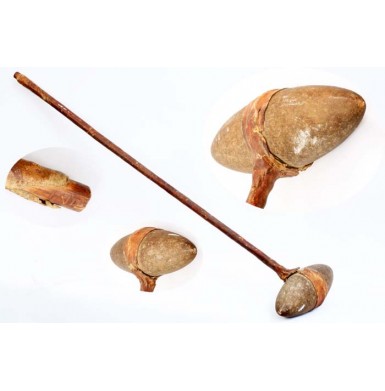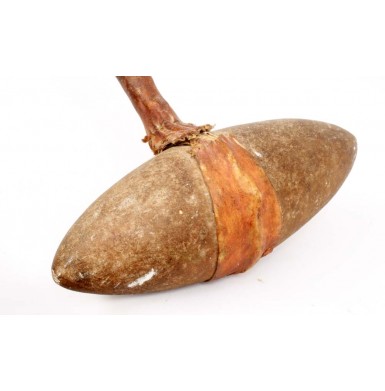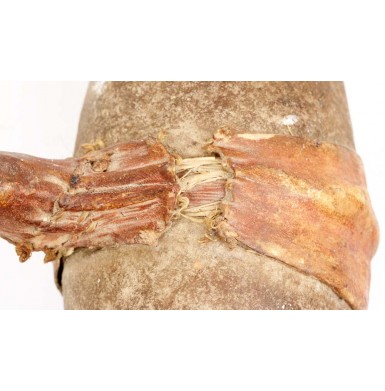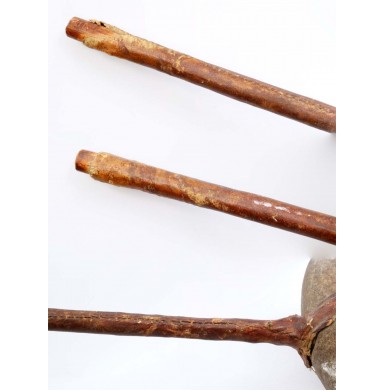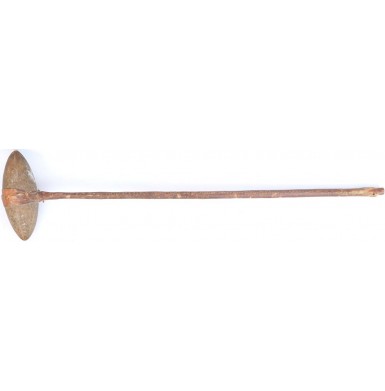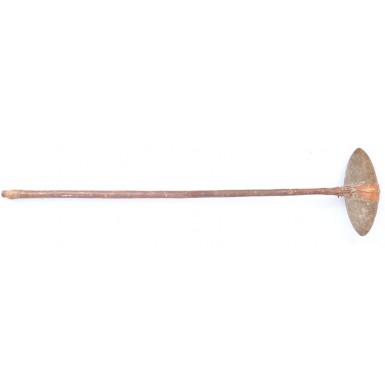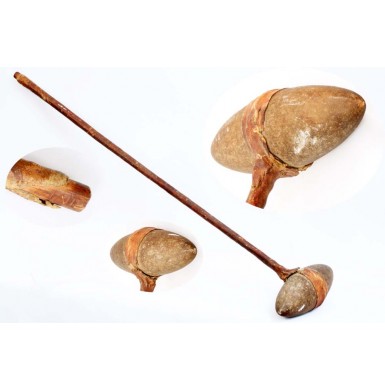Since the dawn of man, the club has been the most prevalent weapon in society. From its humblest beginnings as a fallen limb picked up by pre-historic man to protect himself and his family from predators (both 4 and 2 legged) to the carbon-fiber batons carried by today’s police officers, this simple weapon has remained a standard part of the human arsenal. Although the earliest clubs were simply branches or limbs scavenged from the ground, the club soon became a weapon that was specifically fashioned for the purpose of killing. As pre-historic man made technological advancements, simple carved wooden clubs gave way to early stone headed clubs and axes, with a wooden handle lashed to a stone of convenient size and shape, or even worked to exactly the form the owner wanted. As more advanced assembly techniques were learned, the use of wet rawhide to secure the haft to the stone head became more common. The dried hide shrank to increase the tension and developed a thick protective layer of amazing strength around the stone head and the haft. Throughout America, war clubs (or war hammers) were used by every aboriginal tribe with various types and patterns developing in specific regions. The Iroquois and the tribes of the Eastern Woodlands developed a pattern of club with a large ball head of carved wood with a medium length shaft. This very recognizable club pattern was sometimes modified with the addition of metal spike or blade after contact with Europeans. These tribes also developed a “gun butt” shaped club of carved wood (again often enhanced with metal spikes or blades) after contact with European settlers. On the Great Plains, where wood was scarce and at a premium, the archaic stone headed club, attached to a wooden shaft, was the form most commonly made and used. These plains Indian clubs came in three basic types: a simple round stone attached securely to a wooden shaft with dried rawhide, a variant where the ball of stone was encased in rawhide and a short 2”-3” piece of rawhide secured it to the shaft (forming a sort of American Indian “black jack”), and the most elaborate variant, with an elongated, double headed stone attached to a wooden handle. These double-headed war clubs have become the most recognizable of the Plains Indian clubs, and are the form most often associated with those native people. Prior to the introduction of the horse, these clubs were typically attached to a shaft that was between 12” and 15” in length, providing reasonable reach and power without being unwieldy. After the horse became a part of daily life on the plains, and an indispensible part of native existence, these clubs became longer, often reaching 30” or more in length. The extra length was necessary to be able to adequately attack a mounted warrior from the ground, as well as to attack an enemy on foot from horseback. The extended length provided more force when the stone headed club was swung in an arc, as the farther the weight is from the center of a pendulum, the more gravity acts upon it and the more the force of the swing is magnified. All of these clubs were handmade and no two clubs were exactly the same, although certain features tend to be found on nearly all of them. These stone double-headed clubs typically weighed between 2 and as much as 8 pounds, with 3 to 4 pounds being about the perfect weight for the average warrior. The stone was typically grooved, if not circumferentially, then at least at the point in the lower center where the handle and the stone met. The stone heads were attached to the wooden handles with strips of wet rawhide that were sewn in layers to provide a very secure bond. The wooden handle was also sewn with a rawhide covering to protect and strengthen it and to increase the connection between the haft and the head. At this point the commonalities of design gave way to desires of the maker. The shapes of the double-headed stones ranged from simple ovals and naturally smooth river stones of a convenient shape and weight to carefully worked stone heads with tapered, almost pointed ends, resembling a sort of stone football. In some cases stones with crystal inclusions were utilized and the crystals were thought to lend the club mystical powers. While the shape was certainly up to the maker, the tapered “football” style appears to have dominated from the mid-19 century onwards. Very often some type of “drop” was attached to the end of the handle, ranging from a simple leather thong to secure the club to the wrist to a complicated and artistic drop of either aesthetic or religious importance, or sometimes both. The clubs themselves were also sometimes embellished with artwork that reflected the spiritual nature of the maker’s or owner’s family, traditions and beliefs. This could include the addition of fur, feathers, dyed porcupine quills, beads, paint, fabric or just about anything that was available and struck the fancy of the maker. While it is hard to set firm and fast rules for such items, the more heavily ornamented and decorated clubs were probably more likely to see ceremonial use than real combat, while the simpler, unadorned examples were probably made as real weapons of war. This pattern of club saw use over the entire Great Plains region during the 18th and 19th centuries. Documented examples can be attributed to practically every tribe from as far south as the Mexican boarder of Texas to the Canadian provinces north of the Dakotas and Montana, and from as far west as Colorado and Wyoming, to the eastern boarder of Kansas. Due to their fragile animal hide and natural element construction, extant examples of original 18th and 19th century native American clubs are difficult to attain, and most extant examples are of the more decorated and highly ornamental clubs produced during the latter portion of the 19th century to the turn of the 20th century, often for ceremonial purposes during the reservation era.
Offered here is a wonderful original example of a Great Plains Double-Headed Stone War Club, typical of the pattern that saw use with plains Indians from the introduction of the horse through the end of the 19th century. The club has the classic double-headed form, with the stone head carefully worked and tapered to a “football” type shape. The head measures approximately 7 ““ in length and is about 2 ““ wide at the widest point. The club weighs in at slightly more than 3 pounds, a very comfortable weight for long term carry but a very effective weight for combat. After doing the rather complicated mathematics to determine the kinetic energy in Joules delivered by a 3 pound club with a 30” haft, falling through a 90-degree arc in about “ of a second, the result is that at least 500 Joules of energy would be communicated to the target, not counting any additional energy applied by the actual force of the blow. This calculation was based simply on the club as a “pendulum” falling through the 30” arc described by its handle in .25 seconds. For the sake of comparison, that is slightly more than the muzzle energy of a 9mm pistol round (about 450 Joules of energy) and not tremendously less than that of a .357 Magnum (about 650 Joules)! The stone head is grooved in the center of its base to accept the wooden handle and it is secured to the handle with multiple layers of wrapped raw hide that were applied wet and sewn into place with sinew and then allowed to dry and shrink. The handle was also covered with rawhide and sewn with sinew along a seam that runs the entire length of the 29 ““ long handle. The club appears to have received minimal decoration, with only a coating of monochrome red ocher paint that was applied to the handle covering and rawhide wrap. The rawhide has worn and split at the very end of the handle, leaving about ““ of wood exposed, and may have had a drop or thong attached at that point originally. The lack of significant decoration suggests that this club was meant for business, not ceremonial or dance use. The 29 ““ handle and 32 ““ overall length certainly suggest it was intended for use on horseback. The general appearance and condition of the club suggest it was probably made during the middle or 3rd quarter of the 19th century, at the height of the Indian Wars on the Great Plains. The overall condition of the club as a 150-year-old Native American artifact made of natural material and meant for war is really VERY GOOD. The stone head shows some minor scuffing and indications of some impact around both of the stone “points”. The rawhide wrap that secures the stone head to the handle is well worn and has mostly separated on one side. It is difficult to determine if this is from use, deterioration due to age or from the work of a hungry rodent that gnawed the rawhide. As a result of the wear and separation, the stone head is no longer securely attached to the shaft and will probably come loose completely if the stone is not supported at all times. As such, the club will be carefully packed to support the head when shipped. The head should always be supported when the club is handled, as the weight of the stone itself may separate the head from the shaft. As mentioned earlier, the wooden handle is 29 ““ long and is about 5/8” in diameter and is encased in rawhide as well (making it about 7/8” in diameter), all of which is sewn with sinew. The very end of the handle wrap (about “) has come loose and is worn, exposing the wood at the end of the handle. No drop or thong is present at the end of the club. The rawhide handle and head wrap were all painted with a natural red ocher paint, which has faded, dulled and worn with age, but is still visible on the rawhide. All of the stitching that secures the handle wrap appears to be original and remains tightly in place. At the bottom of the exposed piece of wooden handle, the initials W C have been crudely carved. It is not clear from what era these initials are, but they are likely not as old as the club itself. The club has a lovely, untouched appearance and is a classic example of a mid-19th century Plains Indian war club. While it is almost impossible to identify the tribe that may have produced this club, a review of similar clubs in institutional collections reveals that most are identified as Lakota (Sioux), specifically Oglala. Whether the Oglala had a particular penchant for this style of club, or if most of the institutional examples were simply collected on the Pine Ridge Reservation (South Dakota) during the turn of the century, is difficult to know.
In a world where original Native American relics and artifacts are difficult to obtain due to forgery and fakery, and when those that are original are often very late 19th century artifacts of the reservation era, original, untouched relics like this are highly prized. While this club has some minor condition issues, it still displays very well and is quite likely a real world “working piece” not a ceremonial or dance club. The simplicity of the decoration not only suggests a real combat item, but also a working life before most of the tribes were resettled permanently on reservation lands. Although impossible to know for sure, this club is much more likely to be circa 1850-1880 than it is to be circa 1880-1900. It is a great example of the continued use of an archaic, but very effective, weapon during the era of modern firearms by a people whose honor required them to get “up close and personal” when fighting. This will be wonderful addition to any serious collection of old west and Native American arms, and at a price much more reasonable that they typical $1,500+ these clubs are brining at auction these days.
SOLD
